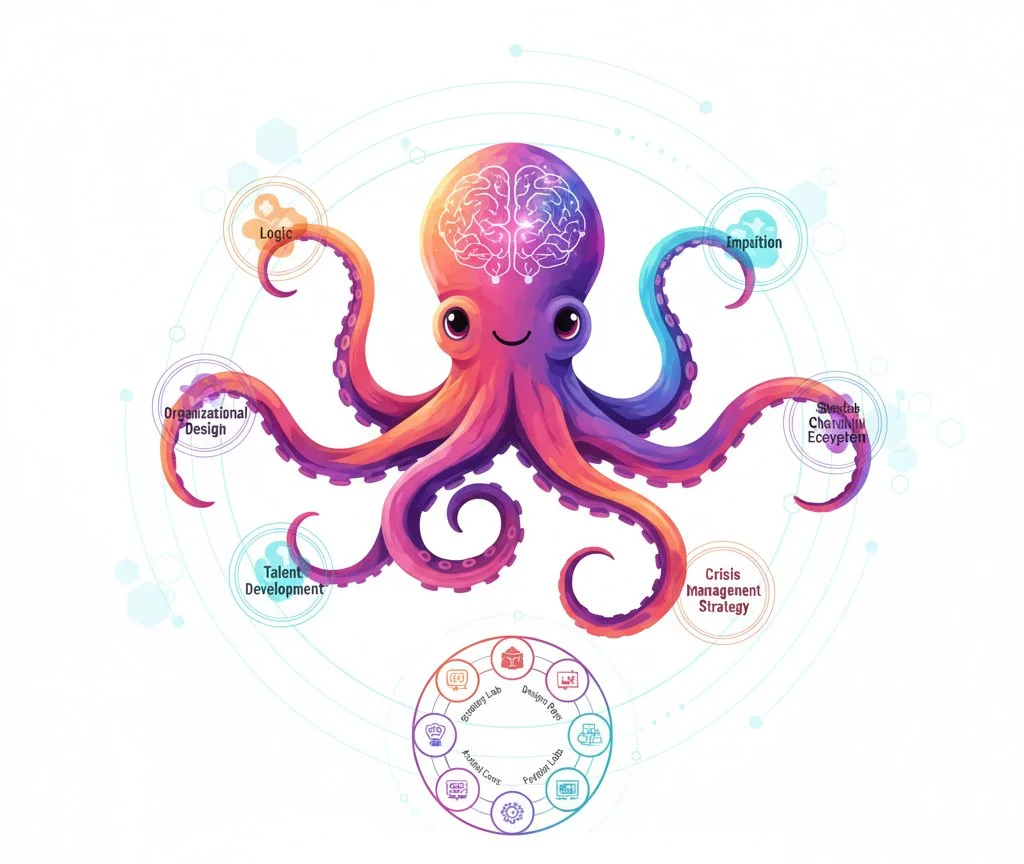The Animal Leadership Series: The Octopus Mindset
AI generated Image
Theme: Adaptive Intelligence and Cognitive Fluidity in Modern Leadership
Introduction
The volatile, uncertain, complex, and ambiguous (VUCA) nature of today’s business environment demands a new leadership paradigm—one that embodies fluid intelligence, emotional range, and strategic adaptability. The octopus, a creature of remarkable intelligence and decentralization, offers a profound metaphor for this transformation.
Much like the octopus that operates with nine brains and three hearts, modern leaders must learn to think with multiple perspectives at once—logic, intuition, and empathy—to sustain coherence in flux. This multidimensional awareness represents the essence of The Octopus Mindset: a model of Adaptive Intelligence that empowers organizations and leaders to reshape, regenerate, and respond with elegance to uncertainty.
In this framework, Sheeba Chandini’s ecosystem—composed of eight interconnected pillars—serves as a real-world manifestation of octopus-inspired leadership. Each pillar operates autonomously yet synergistically, echoing the octopus’s decentralized nervous system and embodying a living model of distributed creativity and governance.
Related Work
Key Concepts
Decentralized Intelligence
Organizational psychology and neuroscience highlight the benefits of distributed decision-making—teams that act semi-independently, much like the octopus’s arms, respond faster and innovate more dynamically. The “invisible brain” concept parallels autonomous leadership ecosystems, where each unit possesses both responsibility and creative agency.Ambidextrous Organizations
The “multiple arms” metaphor aligns with the concept of ambidexterity—the ability to exploit current strengths while exploring new opportunities. Adaptive organizations balance stability and innovation, ensuring they remain both grounded and exploratory.VUCA/BANI Frameworks
The rise of the VUCA (Volatility, Uncertainty, Complexity, Ambiguity) and BANI (Brittle, Anxious, Non-linear, Incomprehensible) paradigms underscores the need for leaders who thrive in chaos, capable of recalibrating their thinking models in real time. The Octopus Mindset turns instability into a canvas for evolution.
Dataset
Sources for Analysis & Case Studies
Biological Analogs
Research on octopus cognition reveals striking parallels with agile leadership. Each arm can make localized decisions through neural clusters, while chromatophores enable rapid camouflage—a metaphor for organizational flexibility and adaptive branding.Organizational Case Studies
Companies such as Netflix, IDEO, and SpaceX exemplify octopus-style agility—reconfiguring structures, strategies, and workflows under pressure without losing identity. NGOs and startups using agile governance frameworks demonstrate similar responsiveness.Leadership Archetypes
Leaders such as Satya Nadella (empathy-driven transformation), Jacinda Ardern (adaptive compassion), and Elon Musk (visionary experimentation) model high Cognitive Fluidity—the simultaneous use of logic, intuition, and empathy in leadership action.Sheeba Chandini Ecosystem (Applied Dataset)
The eight-pillar ecosystem—Strategy Lab, Design Studio, Purpose Pays, Global Care, Academy, Future Labs, Portfolio, and Core Hub—functions as a living dataset of applied Adaptive Intelligence. Each pillar autonomously explores different dimensions (strategy, creativity, impact, service, learning, innovation, expression, wisdom), yet all align under a unifying “Core Hub” of purpose—mirroring the octopus’s centralized yet distributed intelligence.
Methodology
Approach to Develop the Mindset
Metaphorical Modeling
The octopus’s biology informs practical leadership mapping:Three hearts → Strategy (Systemic), Culture (Relational), Execution (Tactical).
Nine brains → Distributed decision centers across teams or organizational pillars.
Chromatophores → Dynamic identity management (brand and communication adaptability).
Ink clouds → Strategic protection and crisis management.
Cognitive Reframing Exercises
Leaders are trained to apply three simultaneous frames—Logic (data), Intuition (vision), and Empathy (human impact)—to one problem, strengthening neural plasticity and emotional range.Simulations & Scenarios
Adaptive drills simulate “flux” environments—such as market shocks or creative disruptions—forcing leaders to reorganize thinking structures rapidly, much like an octopus reshapes itself to escape or adapt.
Results
Expected Outcomes of Adopting the Octopus Mindset
Increased Organizational Agility: Teams pivot faster in uncertain markets through distributed autonomy.
Enhanced Team Empowerment: Decentralized intelligence encourages ownership, creativity, and self-correction.
Improved Crisis Navigation: Leaders maintain calm decision-making under turbulence.
Cognitive Fluidity as Competitive Edge: The ability to shift between analytical, emotional, and intuitive cognition becomes a differentiator in leadership performance.
In Sheeba Chandini’s ecosystem, this manifests as multi-pillar harmony—where AI-driven design, social entrepreneurship, research, and sustainability function as interconnected yet self-sufficient entities—creating a regenerative loop of innovation.
Applications
Practical Implementation Areas
Talent Development
Introduce Octopus Thinking Labs—training modules that nurture multidimensional cognition, emotional regulation, and adaptive reasoning.Organizational Design
Build modular, cross-functional teams resembling neural nodes. Each “arm” operates with strategic autonomy while remaining aligned through transparent feedback loops.Innovation Strategy
Establish safe-to-fail ecosystems, encouraging rapid experimentation, design iteration, and calculated risk-taking—mirroring the octopus’s playful problem-solving.Personal Leadership Coaching
Guide leaders in balancing:The Logic Arm: Data, structure, and foresight.
The Intuition Arm: Vision, creativity, and instinct.
The Empathy Arm: Ethics, connection, and impact.
Ecosystem Integration (SheebaChandini Model)
Within Sheeba’s 8-pillar ecosystem:Strategy Lab acts as the analytical brain.
Design Studio embodies intuitive creation.
Global Care channels empathetic purpose.
Academy nurtures continuous learning.
Purpose Pays integrates profit with impact.
Future Labs drives innovation and AI experimentation.
Portfolio reflects identity and visibility.
Core Hub synchronizes all — the “central brain” ensuring coherence in diversity.
Resources
Recommended Readings
Thinking in Systems: A Primer – Donella H. Meadows
A foundational text for understanding feedback loops, interdependencies, and systemic balance—key to grasping octopus-like organizational intelligence.The Fifth Discipline: The Art & Practice of The Learning Organization – Peter M. Senge
Establishes the framework for learning organizations—emphasizing shared vision, mental models, and systemic thinking as tools for collective intelligence.Complexity: A Guided Tour – Melanie Mitchell
Explains how complexity arises from simple rules, offering insights into emergent behavior—a direct foundation for Cognitive Fluidity and adaptive leadership.The SheebaChandini Ecosystem (Applied Resource)
A living laboratory where systems thinking, adaptive creativity, and ethical design converge. It exemplifies the Octopus Mindset in practice: decentralized intelligence connected by shared vision and purpose.
Citation
Meadows, D. H. (2008). Thinking in Systems: A Primer. Chelsea Green Publishing.
Senge, P. M. (1990). The Fifth Discipline: The Art & Practice of The Learning Organization. Doubleday.
Mitchell, M. (2009). Complexity: A Guided Tour. Oxford University Press.
Chandini, S. (2025). The Octopus Mindset: Adaptive Intelligence in Modern Leadership. SheebaChandini LLC Internal Ecosystem Research Notes.

